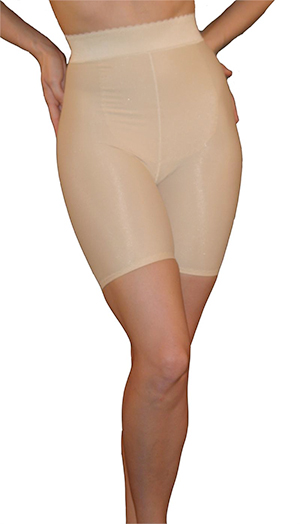Thigh Lift Surgery
-
 Written by Andrew Proulx, MD | Medically Reviewed by EnhanceMyself Medical Team | Last updated 10/17/2023
Written by Andrew Proulx, MD | Medically Reviewed by EnhanceMyself Medical Team | Last updated 10/17/2023 - Overview
Overview
What is a thigh lift?
The thighs are an area that tend to accumulate excess fat and saggy skin. This is especially the case with women, as the hips and thighs are areas of major fat deposits in the “female fat distribution” type. Thigh lift surgery is a procedure that lifts and tightens loose skin from thighs, improving the contour of the thigh and buttock area.
Cost of thigh lift surgery
The average cost of thigh lift surgery is between $5,000 and $10,000. Some factors that can typically influence the cost include:
- Surgeon’s Fee: The experience and reputation of the surgeon performing your thigh lift procedure can affect the cost. Highly skilled plastic surgeons often charge a premium for their services.
- Anesthesia The administration of anesthesia involves the expertise of an anesthesiologist. The type of anesthesia used, the duration of the procedure, and the qualifications of the anesthesia provider influence the anesthesia fees.
- Types of Thigh Lift: The extent of your thigh lift procedure will impact cost.
- Surgical Facility: The surgical facility where your thigh lift is being performed may impact the cost. These fees cover the usage of the operating room and other associated services.
- Location: The cost of living and the average pricing for medical services in a particular area can affect the cost of your procedure. In general, urban areas tend to have higher procedure fees.
- Medical Care: The care provided before and after affects the overall cost. This includes preoperative consultations, medical tests, surgical garments, prescription medications, and follow-up appointments.
- Added Procedures: Thigh lift surgery is sometimes combined with other procedures, such as liposuction or other body contouring surgeries. If additional procedures are included they can contribute to the overall cost.
If you are considering thigh lift surgery, setup a consultation with a board-certified plastic surgeon near you. This will allow you to discuss your aesthetic goals and gain a better understanding of the specific costs involved.
Are you a candidate?
In general, you may be a good candidate for thigh lift surgery if you are:
- In good overall health
- No medical conditions that can impair healing or risk of surgery
- Your weight is relatively stable
- You have soft tissue along the inner (medial) thigh region and/or the outer (lateral) thigh
- A nonsmoker
- Committed to leading a healthy lifestyle
Types of thigh lifts
The type of surgery chosen is based on each individual’s goals and desires. Each type of procedure has its own target area, outcome expectations, and recovery time. The major types of thigh lift include:
- Mini Thigh Lift
- Medial/inner
- Vertical
- Outer/lateral
- Posterior
- Spiral
Thighplasty methods
Mini Thigh Lift
- Purpose: to reduce sagging in the upper part of the inner thigh. Instead of tightening the entire thigh, this method only targets the upper third of the inner thigh. Individuals who have a mild amount of excess skin and want their thighs to appear more toned are perfect candidates for the mini thigh lift.
- Procedure: A small incision in the groin region is used to perform liposuction and subsequent removal of excess skin. It takes about 2 hours from start to finish. The end result is a smoother appearance of the inner thigh with no bumps or dents.
- Recovery: Since this is the least invasive of the procedures, recovery time is quick. The patient can begin light exercise after 2 weeks.

Thigh lift surgery recovery garment photo courtesy of www.NouvelleInc.com
Medial/Inner
- Purpose: to remove excess skin and fat in the upper inner thigh region when diet and exercise alone do not suffice. This is the most common procedure for people who have lost large amounts of weight in a short time. However, aging can also cause sagging in the inner thigh.
- Procedure: The surgeon makes an incision along the crease where the thigh meets the pubic region to minimize visible scarring. Then, the surgeon removes excess skin and fat, using liposuction if necessary. The skin is pulled and lifted tighter to give a firm appearance.
- Recovery: Immediately after surgery, there will be bruising, swelling, and soreness. The patient should remain relatively sedentary in the first two weeks to help the healing process. Over a period of one month, he or she can engage in light activities, but should not return to full activity until eight weeks post-operative. In the first month following surgery, the patient must wear a compression garment to promote proper contouring of the thighs.
Vertical
- Purpose: For people who have excess skin and fat around their entire thigh (not just upper inner), the vertical thigh lift is most appropriate. This procedure focuses on the middle and lower sections of the thigh as well. Since it is more invasive, the vertical thigh lift is only recommended for people who need extensive amounts of tissue removed.
- Procedure: Vertical lifts require a larger incision, where a graft of skin is cut and removed from the upper inner thigh to the medial (inner) knee area. It gets the nickname “crescent lift” from its ellipse-shaped incision. Excess skin and fat are removed, and then the skin is pulled tighter. The scar following surgery will appear like a “T” in the inner thighs but will not be visible with the legs closed.
- Recovery: This procedure is more extensive, and thus requires more recovery time. Bruising and swelling may be more noticeable, and there may be more post-operative pain. The surgeon should discuss all post-operative expectations prior to the procedure. Depending on the extent of surgery, the patient may need to wear compression garments for up to eight weeks and remain on light activity status until 12 weeks post-op.
Outer/Lateral
- Purpose: to remove excess tissue that accumulates around the outer thigh region, which may include the waist and buttock regions. Many people suffer from fat and cellulite accumulation in the outer thigh and buttocks, making this method ideal for such situations.
- Procedure: The surgeon makes an incision around the waist, after which liposuction is used to remove excess fat from the outer thighs and buttocks. The skin is then pulled tighter and anchored at the hip bone. Scarring is extensive in this method but is usually covered by underwear and bathing suits.
- Recovery: More scarring requires more recovery time. The area of the bruising will be higher on the legs and hips due to the location of the incisions. The patient will have to find ways to rest without putting too much pressure on the incisions, which may involve lying prone (on the stomach).
Posterior
- Purpose: This procedure targets fat, saggy, and excess skin in the posterior thigh and buttocks.
- Procedure: Incision sites will differ from person to person based on their anatomy, magnitude of liposuction, and desired outcomes. Most will end up with scarring that is minimally visible while wearing underwear or bathing suits.
- Recovery: The location of bruising for this procedure will be near the “sit bones,” which will make it uncomfortable to sit normally for the first few weeks.
Spiral
- Purpose: The newest of the thigh lift techniques, this procedure targets the entire thigh— the front, back, upper, lower, inner, and outer. While removing excess skin and fat, it also leaves the contour of the thigh and buttock smoother and firmer.
- Procedure: As this procedure is the most extensive, it requires the largest incisions and leads to the most extensive scarring. Incisions are made along the inner groin down to the knee, and another is made from the groin to the hip bone. The “spiral” part comes from where the incisions meet along the posterior waist at the top of the buttock. The legs and buttocks are left smaller, firmer, toned-looking, and shapelier.
- Recovery: This requires the most recovery time given the amount of suturing necessary. The patient must return for regular follow-up visits to the surgeon to ensure the wounds are draining properly, incisions are healing well, and no infections are present.
Alternatives to thigh lifts
While thigh lift surgery is a highly effective options for improving the appearance of the thighs, there are alternative treatments available that may be suitable for individuals seeking less invasive options. Here are some alternatives to consider:
- Non-surgical Skin Tightening: Non-surgical skin tightening treatments, such as radiofrequency (RF) or ultrasound therapy, can help improve skin laxity and tighten the appearance of the thighs. These treatments use energy-based devices to stimulate collagen production, resulting in gradual skin tightening over time. Generally results are limited when dealing with excess skin.
- Laser Therapy: Laser treatments, such as fractional laser resurfacing or laser skin rejuvenation, can improve the texture and tightness of the skin on the thighs. They work by stimulating collagen production and addressing issues like cellulite or uneven skin tone.
- Body Contouring Treatments: Non-invasive body contouring procedures, such as cryolipolysis (CoolSculpting) or ultrasound cavitation, can help reduce localized fat deposits in the thighs. These treatments target fat cells, causing them to be eliminated naturally by the body over time.
- Exercise and Strength Training: Regular exercise and targeted strength training exercises that focus on the thighs can help improve muscle tone and firmness. Exercises like squats, lunges, and leg presses can strengthen the muscles in the thighs, contributing to a more sculpted appearance.
- Compression Garments: Wearing compression garments, such as compression shorts or leggings, can provide temporary tightening and support to the thighs. These garments can help smooth out the appearance of the thighs and provide a more streamlined look.
It’s important to note that these alternative treatments may have limitations in terms of the extent of improvement achievable compared to surgical thigh lift procedures. Speak with a qualified healthcare provider to determine the most appropriate treatment option based on your specific needs.
EnhanceMyself.com relies on sources such as professional medical organizations, government agencies, academic institutions, and peer-reviewed scientific journals to write it’s articles. Learn more about how we ensure our content is accurate, in-depth, and unbiased by reading our editorial guidelines.
*Medical Disclaimer: This website does not provide medical advice. Read more.


